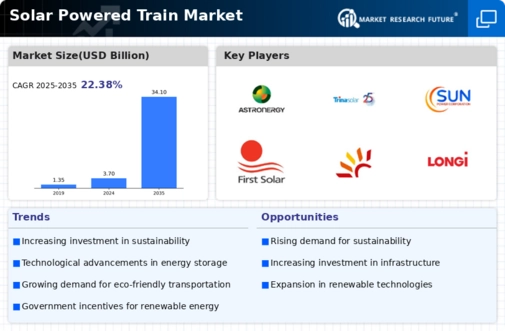Rising Environmental Concerns
The Solar Powered Train Market is increasingly influenced by rising environmental concerns among consumers and stakeholders. As awareness of climate change and pollution grows, there is a heightened demand for sustainable transportation solutions. Solar-powered trains present a viable alternative to traditional diesel-powered trains, significantly reducing greenhouse gas emissions. Research indicates that transitioning to solar energy in rail transport can cut emissions by up to 80%. This shift aligns with global sustainability goals and resonates with environmentally conscious consumers, thereby driving demand for solar-powered trains. The growing emphasis on reducing the carbon footprint in transportation sectors is likely to propel the solar-powered train market forward, as stakeholders seek greener alternatives.
Government Support and Policy Frameworks
The Solar Powered Train Market benefits significantly from supportive government policies and initiatives aimed at promoting renewable energy. Various governments are implementing frameworks that incentivize the adoption of solar technologies in public transportation. For instance, subsidies and tax breaks for solar-powered train projects are becoming more common, encouraging investment in this sector. Additionally, regulatory measures that mandate reductions in carbon emissions are pushing rail operators to explore solar energy solutions. Recent statistics indicate that countries with robust policy support for renewable energy have seen a 30% increase in solar train projects. This governmental backing not only fosters innovation but also creates a conducive environment for the growth of the solar-powered train market.
Economic Viability and Cost-Effectiveness
The Solar Powered Train Market is witnessing a shift towards economic viability and cost-effectiveness as solar technology becomes more affordable. The decreasing costs of solar panels and related technologies are making solar-powered trains a financially attractive option for rail operators. Recent data suggests that the cost of solar energy has dropped by nearly 80% over the last decade, making it competitive with traditional energy sources. This trend is encouraging rail companies to invest in solar-powered solutions, as they offer long-term savings on fuel and maintenance costs. Additionally, the potential for energy independence through solar power further enhances the economic appeal of solar trains, positioning them as a smart investment for the future of rail transport.
Technological Innovations in Solar Energy
The Solar Powered Train Market is experiencing a surge in technological innovations that enhance the efficiency and effectiveness of solar energy systems. Advances in photovoltaic technology, such as the development of bifacial solar panels, allow for greater energy capture, which is crucial for powering trains. Furthermore, energy storage solutions, including advanced battery systems, are becoming more sophisticated, enabling trains to operate even during periods of low sunlight. According to recent data, the efficiency of solar panels has improved by approximately 20% over the past decade, which directly impacts the operational capabilities of solar-powered trains. This technological evolution not only reduces operational costs but also increases the attractiveness of solar-powered trains as a sustainable transportation option.
Increased Investment in Renewable Energy Infrastructure
The Solar Powered Train Market is benefiting from increased investment in renewable energy infrastructure. As countries strive to meet their energy needs sustainably, there is a growing focus on developing solar energy facilities that can support rail systems. Investments in solar farms and energy storage systems are on the rise, providing the necessary infrastructure for solar-powered trains to thrive. Recent reports indicate that investments in renewable energy infrastructure have surged by over 50% in the past five years, reflecting a strong commitment to sustainable energy solutions. This influx of capital not only enhances the operational capabilities of solar-powered trains but also fosters innovation and development within the industry, paving the way for a more sustainable future in rail transport.

















Leave a Comment